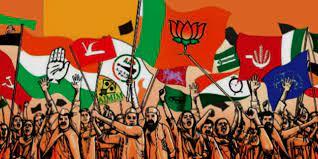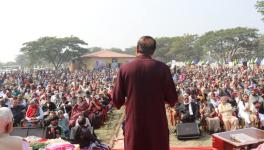Indian Polity: The Story of Two Transitions

What Indian society desperately needs is a healthy combination of the hardware of economic growth which would create affluence and the ideological software of Statism, nationalism, secularism and democracy, which would distribute affluence and absorb the social poison produced by growth.
—–
It may be argued that the Indian polity has gone through two major transitions since independence. These two transitions are not just different from each other. They stand in complete contradiction with each other. They do not constitute one big composite picture. Instead, the second transition stands in complete opposition to the first and threatens to undo some of the major gains made during the first transition. What is the story of the two transitions?
The period 1947-52 was easily the most transformative period of Indian history. Never before in the past had a transformation of such magnitude taken place in such a short duration. This was the period of Indian revolution. It was the Indian Revolution.
Fundamental changes
Five fundamental changes occurred during this period. One, India became independent, ending two centuries of alien colonial rule. Two, India’s internal boundary-lines were re-drawn and fixed with the integration of over 500 princely states into the Indian Union. Three, India ended feudalism in agriculture by abolishing the system of landlordism. This paved the way for the transformation in India’s agricultural profile, with 20 million tenants getting ownership of land they had been cultivating.
Also read: Undermining the idea of India
Four, Indian people gave to themselves, through their representatives, a progressive, modern and emancipatory constitution, containing the blueprint for India’s social transformation. And five, India organized the largest democratic mandate held anywhere else in the world. India became the citadel of the democratic experiment in the world.
This was the first Indian transition which created its own ideas and institutions that became the foundation principles of the Indian republic. Democracy was to guarantee peoples’ participation. Indian nationalism was to reach out to all Indians irrespective of religion, language, region and culture. The State was to be the enabler of basic economic processes, ensuring both growth and distribution.
Secularism, in the form of religious freedom, was to be the bedrock of the Indian system. This was the general outline of politics and society. All in all, it seemed a happy plot. To be sure, India still remained a poor country – a large country with a small economy – but people had a good reason to be optimistic about the future.
Also read: Is India governed by the principles and norms laid down in the Constitution of India?
Jawaharlal Nehru thought in the 1950s that India was the most exciting country to live in and observe. It was a country that was trying to achieve a social transformation in a modern direction while retaining some of the positive features of its traditions. It was also trying to achieve industrialization within a parliamentary democratic framework.
These tasks were historically unprecedented and if the Indian experiment could be successful, it would serve as a model for a large number of non-European countries, trying to reach the shores of affluence without paying too much of a price for it. It made great sense for any patriotic Indian to feel very optimistic about the collective future of the Indian people. Indeed it was perfectly realistic to be optimistic. Both the leaders and their followers showed great confidence that together they would be able to weather the storm. The world outside watched India with great curiosity and apprised Indian society not on the basis of its present condition but the promises and potentials it showed.
India in the 1950s was really a place to look out for, even though, on the scale of affluence, it ranked among some of the poorest countries of the world. This was largely because independent India, in its journey towards modernization, had made some interesting and unusual choices. If successful, Indian experiment could serve as a ‘model’ for the rest of the world.
“The period 1947-52 was easily the most transformative period of Indian history. Never before in the past had a transformation of such magnitude taken place in such a short duration. This was the period of Indian revolution.
Rabindranath Tagore’s pan-human universalism, Gandhi’s non-violence and Jawaharlal Nehru’s non-alignment invested the Indian experiment with aura and prestige. It became evident that India was searching for credible answers to some fundamental answers regarding human life itself. Once the answers were found, they would be available for every society and country. India in the 1950s was not simply a country. It was a huge social laboratory for all of humanity. It was for some of these reasons that India aroused admiration, curiosity and also envy in the rest of the world.
Also read: What does citizenship mean in India?
If the leaders of those times were to visit India now, they would surely be disappointed. Poverty reduction has been slower than anticipated. The social fabric appears more fragile than before. Politically the country is more turbulent and violent than before. There is an air of intolerance in the air. Communalism and casteism, instead of diminishing, have become more resurgent and aggressive. All the major values championed by the freedom struggle and enshrined in the Constitution are under siege.
As a nation, we are politically unstable, ideologically hysterical, socially turbulent and economically precarious. We arouse neither admiration nor envy in the world. The great Indian experiment does not appear to be working. Something very basic seems to have gone wrong. Is there an explanation for the fall from the exalted heights of the 1950s when India stood tall amongst the community of nations and claimed to offer something to the world?
Around the time of independence, it was hoped and believed that the great Indian march to Modernity would be helped by four key-ideas (and their accompanying institutions) which would keep the march firmly on track and prevent it from getting derailed. These ideas were seen like important vehicles which would facilitate India’s march ahead.

First was the idea that the State would be the major agency for carrying out the social transformation. The idea of State as the major instrument in carrying out the social transformation was particularly crucial for a society that had experienced two centuries of alien, unrepresentative State, not interested in the long-term development of the society and people. Two, a healthy and robust nationalism, practised during the days of freedom struggle, would keep the country united in spite of social disparities. Three, Secularism would create social harmony and provide security to minorities and other social groups at the margins. Four, democracy would create genuine empowerment of the people cutting across differences of class and community. The leaders of independent India displayed great faith in these values and hoped that these four key-ideas – Statism, nationalism, secularism and democracy – would act like effective shields and neutralize all the possible ill-effects inherent in economic growth and absorb the turbulence created by it.
The second transition
This was the kind of landscape that emanated from the first transition. The second transition was initiated during the initial years of the 21st century and has been the antithesis of the first one. Democracy appears perilously close to becoming a mobo-cracy. The plural nationalism has been hijacked by a majoritarian one. The State, instead of being an enabler, has developed an adversarial relationship with the people. Secularism appears like some distant, long-lost dream. In general, there is a sense of civilization, liberty and decency in a state of siege, and it is very precarious and fragile.
All the four major ideas – Statism, nationalism, secularism and democracy – that were built up during the first transition and were supposed to act as bulwarks to protect the society and the people from the ill-effects of economic growth, have declined and ceased to have the palliative effect they were expected to. Some have been eroded. Some have been dismantled and some have been diverted into socially regressive channels.
Indian society has experienced a phase of unprecedented economic growth particularly during the last three decades. This growth has created a mammoth social churning almost like a Sagar Manthan (a mythical churning of the ocean by the gods and demons in search of nectar) of Hindu mythology. This Manthan, much like the original Sagar Manthan, has produced both the nectar of growth and the poison of social tension.
“Indian society has experienced a phase of unprecedented economic growth particularly during the last three decades. This growth has created a mammoth social churning almost like a Sagar Manthan (a mythical churning of the ocean by the gods and demons in search of nectar) of Hindu mythology.
It is generally believed that any transition of such scale and magnitude cannot possibly be smooth and painless. It produces disparity, displacement and traumas of various kinds. In other words it produces the social poison along with the nectar of affluence. This has happened to India also. It was hoped by the leaders of the freedom struggle that the ideas of Statism, nationalism, secularism and democracy would provide a safety cover, which would help absorb the poison and enable the distribution of the nectar. That has unfortunately not happened. These ideas constituted a social force and were vibrant and active at a time when there was very little growth in India during the 1950s and early 1960s. By the time the phase of rapid growth came (since the 1990s), these ideas have been bruised and damaged and their social effectivity greatly diminished.
Hence the pessimism. What Indian society desperately needs is a healthy combination of the hardware of economic growth which would create affluence and the ideological software of Statism, nationalism, secularism and democracy, which would distribute affluence and absorb the social poison produced by growth.
Most unfortunately for the Indian society and people, this combination of economic hardware and the ideological software has been missing. The Nehru era possessed the ideological software but not the hardware of rapid economic growth. The last three decades have experienced rapid growth but without the much needed ideological software.
It is true that the Indian economy has grown rapidly and has demonstrated the capacity to spread affluence to people. The axial question is: during the process of economic transformation how much of the social cost would be paid by the Indian people and society? How much of the innate and intrinsic India would remain intact? This is the mother of all questions and all those who truly love India must surely ponder over it.
At the heart of this question is the very idea of India articulated so eloquently by Tagore, Gandhi and Nehru. How much of this ‘Idea’ would survive in the process of India’s transformation? But what is this Idea of India which may be considered the very DNA of Indian society?
In a nutshell, the idea of India is the idea of pluralism and diversity. The big subterranean ideational contest in India appears to be between ‘unitarianism’ and ‘pluralism’. To get it right, plurality or diversity is part of India’s condition. It has not been created or invented by any ideology or vision. It is simply there.
“The second transition, initiated during the initial decades of the 21st century, has threatened to undo the major socio-political gains made during the first transition.
The question is: what to do with it. Both unitarianists and pluralists tend to look at this diversity differently. The former want this existing diversity to be dominated by one religion, or language, or culture, or whatever. Clearly, domination, discrimination and exclusion are inherent in this vision. It can also lead to conflict (given that those who are discriminated against, will resist domination, which will lead to friction and conflict, also violence).
The pluralists tend to uphold and celebrate this diversity. They look upon India’s plurality not as a liability or an embarrassment, but as a strength and want to preserve and promote it. But there are obviously risks in this: sometimes they become somewhat majoritarian and sometimes they reach out to minorities, inviting the allegations of minority appeasement. It is always a tight-rope walk, with a possibility of tilting a bit more on one side and then on the other. This then is the big contest on the Idea of India, with two principal contestants. This is the big dichotomy.
This then is the story of the two big transitions in Indian polity. The first transition, initiated during 1947-52, created the ideational and institutional infrastructure for pluralism. The second transition, initiated during the initial decades of the 21st century, has threatened to undo the major socio-political gains made during the first transition.
Indeed, the whole trajectory appears to have been reversed. This is the anti-thesis of the essential Idea of India. How would these contests be played out or resolved in the coming decades? This is the big question haunting Indian polity today.
[The article draws from “The Colours of freedom”, written by the author and published in Deccan Herald on August 14, 2016.]
Salil Misra is a historian at the Ambedkar University, Delhi (AUD)
Get the latest reports & analysis with people's perspective on Protests, movements & deep analytical videos, discussions of the current affairs in your Telegram app. Subscribe to NewsClick's Telegram channel & get Real-Time updates on stories, as they get published on our website.
























